It seems everyone is interested in how to make your own beehive in a jar. Have the rows of organic honey jars at the farmers market got you thinking about starting your own backyard beehive? If you live in a suburban area, you may think that starting a beehive cannot be done. However a common suburban backyard can be a perfect place for beehives if done correctly and you do a bit of research and planning before ordering your bees and supplies. It is actually a very simple and easy process with the right tools. Everything you need is below including a supplies list and pictures of our DIY beehive.
Materials Needed TO Make Your Own Backyard Beehive In A Jar:
1 – Piece of 2″ x 12″ x 6′ wood (cut 2 pieces for the sides to 22″)
1 – Piece of 2″ x 12″ x 6′ wood (cut 2 pieces for the front and back to 18″)
1 – Piece of 1″ x 1″ x 6′ wood (cut 2 pieces for the top frame left and right sides to 22″)
1 – Piece of 1″ x 1″ x 6′ wood (cut 2 pieces for the top frame front and back to 18″)
1 – Piece of thick plywood (cut to 16″ X 20″)
1 – Bottom beehive kit (for the bees to enter and exit)
12 – Big mouth quart sized jars (for honeycomb)
1 – Box of wood screws (size 1″ screws)
1 – Can of wood stain (use a dark wood stain of your choice)
And of course, you need bees, most bees are available only in March and April but you can try these links to order your honey bees online – 3lbs of honey bees – Queen Bees For Sale
 First get a piece of thick plywood and cut to 16″ x 20″.
First get a piece of thick plywood and cut to 16″ x 20″.
Then measure and center for 12 holes and drill the pilot holes.
Next, drill 12 – 3 1/2″ holes with a hole saw (for the jars to fit into).
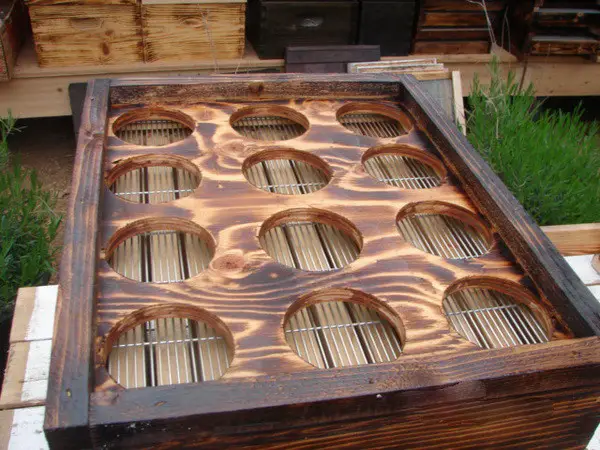 Next cut 2 – 22″ pieces from a 2″ x 12″ x 6′ board and 2 – 18″ pieces from a 2″ x 12″ x 6′ board.
Next cut 2 – 22″ pieces from a 2″ x 12″ x 6′ board and 2 – 18″ pieces from a 2″ x 12″ x 6′ board.
Then screw everything together and stain the wood with dark wood stain (or whatever you choose).
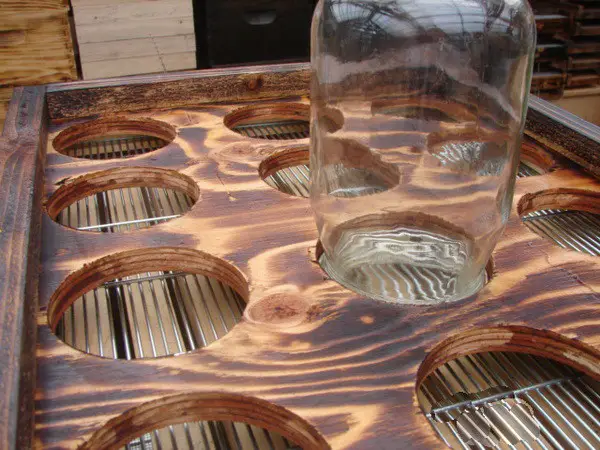 Get your 12 wide mouth mason 1/2 gallon size jars (or a normal quart sized jar).
Get your 12 wide mouth mason 1/2 gallon size jars (or a normal quart sized jar).
Then arrange them and make sure they all fit properly over the holes.
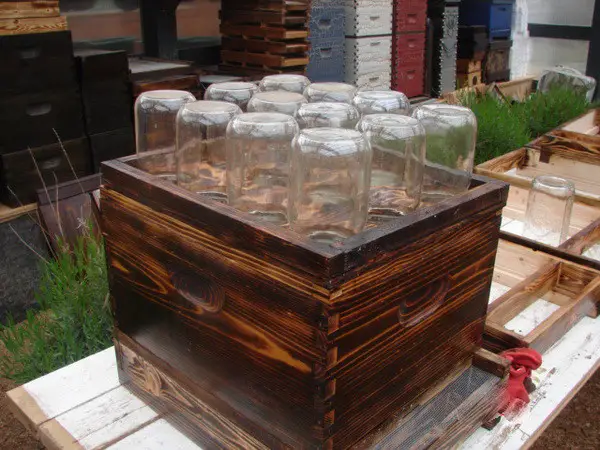 Here is the 12 beehive jars arranged and installed in our backyard beehive.
Here is the 12 beehive jars arranged and installed in our backyard beehive.
The jars sit with the screw lid on for less than 1/16″ gap between the jar and the beehive hole.
You may need to add some shims to support the weight so it won’t sag with the weight of the honey.
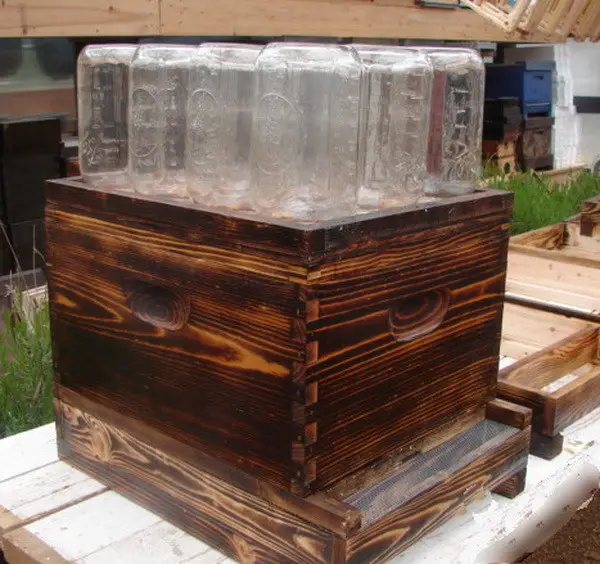 Another view of our DIY backyard beehives in a jar project.
Another view of our DIY backyard beehives in a jar project.
You can vent and screen this chamber if there is excess heat or put the beehive where it gets late day shade.
The bottom wooden piece we purchased as a kit and this is where the bees enter and exit the beehive.
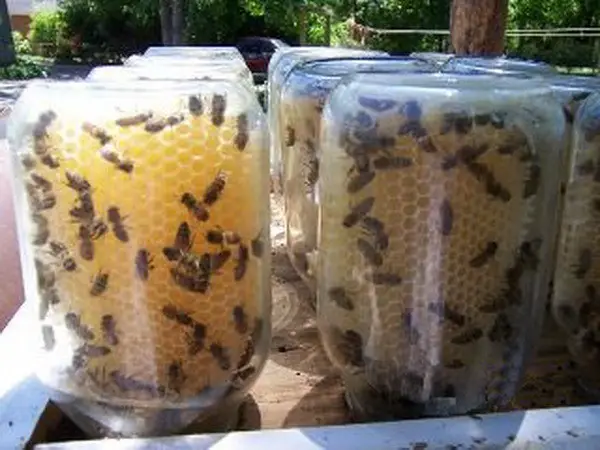 The bees are seen here after we added them to the jars, they are now ready to make organic honey.
The bees are seen here after we added them to the jars, they are now ready to make organic honey.
 After much time, here is what the honeycomb jars look like filled with honey.
After much time, here is what the honeycomb jars look like filled with honey.




Thanks for the video. I’m in pest control and get called out to numerous Bee jobs. If they’re aggressive, they get the chemical. If they’re pretty calm, I try and smoke them and retrieve the hive. I’ve got two hives this summer that were chemical free and pulled over 7 quarts of pure honey out of them. Family and friends have loved it. I’ve had to teach myself how to remove bees safely without getting stung or as much when their aggressive. I hope to start a beehive in my backyard and a buddies farm next summer. Thanks again.
Chew it, eat the honey. Dont throw away the comb, melt it and make candles!
I’m confused on dimensions. The sides are 18″ and 22″. Because the box joints overlap by 1″ on each end (not by 3/4″ as for dimensional 1x lumber), when assembled, the opening is 16″ x 20″, the same size as the plywood top with the 3-1/2″ holes. Therefore, the top fits into the opening but has no way to be attached to the sides. Obviously that’s not the case. How is the plywood attached to the sides? My best guess is that the top is actually 18″ x 22″, but after the 1″ x 1″ frame pieces are installed, the usable space is 16″ x 20″. Is the top sandwiched between the frame and the sides? Unfortunately the pictures are not large enough to see if that’s the way they’re assembled. Thanks for the fun idea.
First, this is NOT a project for a beginning beekeeper. The jars only have the screw ring but NOT the lid on them, so the jar is still open. The bees will build comb in the jars and fill and cap the comb with honey. When you remove the jars, you allow the bees to exit the jar, you then take extra honey from extraction and fill the rest of the space in the jar and then put the lid with seal on it.
How do you get organic honey unless its in the middle of 2000 acres? Bees forage up to 2 miles. Also how do you get the bees removed and honeycomb uncapped if its in the jar?
I enjoyed your beehive in a jar
We raise bees also, but are confused at why the honey does not run back out of the upside down jars when they’re on the box?
It always amazes me how people have questions but don’t take the time to read the information in front of them. Simply amazing. Thank you for this awesome tip about bees and honey and hives. Read, people, read!
thank you matt for clarifiying i love bees and want to do this project one day.
Hi there! This looks amazing!
Some questions though:
What does the box look like from the inside? Is it empty? Or do you need to put some kind of frames in it?
Doesn’t the honey drip down from the jar?
When you screw a jar with honey off, how do you get the bees out?
Hope any kind bee person has some answers! Thanks in advance :)
Anne
Lots of misinformation in the comments section, along with somegood questions. The jars have the screw lid on, but NOT the metal cap. In other words the jar mouth is completely open. The board with the holes that the jars fit in to sit on top of the bees brood chamber. The brood chamber is where the main bee hive is… where the bees raise their young and live. Bees store their honey directly above their brood chamber (and some IN the brood chamber). Normaly beekeepers put boxes called “supers” above the brood chamber for the bees to use to draw the honey comb and store the honey. In thise scenario, instead of boxes they put the board with the jars on top. The jars fill the holes of the board, and the board covers the hive so that rain and sun don’t get in. In hot areas it needs to be in the shade or the jars cook and tansfer heat into the hive. No wax foundation is put into the jars. Bees have been building honey comb for millions of years without human wax foundation. The jar is simply an empty cavity (like a tree cavity) where they can build comb to store honey. The bees build the comb, fill the comb with honey, and then cap the comb with wax so the honey doesnt drain out. The bee keeper then removes the jars once it’s capped, and fills it up the rest of the way with honey that’s been extracted from normal hives. You then dip the honey out with a spoon. As you get down into the comb, you use a spoon to dig out chunks of comb filled with honey. When you do it this way, you mash it all up together (comb and honey) and spread it on toast, or put it in tea, or eat it straight (or however else you eat honey). The wax is a bit chewy, but perfectly safe to eat, and rather tasteless. It’s the honey that tastes amazing! Hope this helps…
My Dad used to always get honey with the comb in it because he knew it was pure and unprocessed. someone asked “what do you do with the comb”…You chew it! lol, its wax with honey instead, its great, or was when I was a kid! My only question is, how do you start it, where do you get the first queen and workers,,,buy them….because I have no idea where you would get wild bees.
this is the best way for produce honey in a jar! thanks.
The bees make the comb in the jars and will fill the comb with honey. Lids stay off while jars are on hive. Cover the jars with deep super and lid. The jars get filled with honey by you after the bees are done with the comb.
If your worried about weather just put on a frame box and lid. Just leave the frames out
I am not a bee person but I do eat honey. My question is why would somebody want the honeycomb? For example if I bought this jar of honey what would I do with the honeycomb? It seems it would be in the way.
This was actually a fairly common practice in the late 1800s, and beekeepers competed (at county fairs, etc.) to have the loveliest comb drawn out in glass globes that had been attached to the rest of the hive. I do believe the bees fill most if not all the comb with their own comb, then the beespace between the honey combs is filled with extra honey.
I tried this about 2 weeks ago in lieu of a regular honey super (above 2 deeps) covered with a medium super and telescoping outer cover – after about 10 days with no real activity in any of the pint jars I replaced with a conventional honey super — once that is 85 – 90% full I will retry to see if the bees will take to it. I may drop some melted beeswax into the jar bottoms before inverting for the honey super to give them a base to start from this time. One concern is ventilation as this closes off the normal inner cover venting — i may add some screened vent holes to between jars or possibly replace the center jar (or jars) to ensure the bees don’t get too hot…
@Karen (and others that made similar comments): The bees build out the comb in the jars. You would remove the jars when they are all drawn out. Turn the jars right side up. Add your own honey from a prior extraction. It’s a novelty idea to either increase the wow factor (so you can charge a higher price), or to give away as a gift that is unusual and unique. Note; you cannot remove the comb without destroying it. You add your own honey…the bees don’t do it. This is not in lieu of a normal beehive system. You will still need at least two brood chambers below this setup. The bees will build the comb without you needed to add wax. Bees create wax from 8 wax-producing glands on their sides, which is what they do naturally in the wild. The goal here is to provide a novelty item, and not a jar that you would want to extract the comb or honey from. That defeats the purpose of this project. Finally, I recommend that an empty super be placed over the jars to block the heat and sun.
I was told by a beekeeper that the bees only make the comb and the honey is just poured in over the honeycomb. She said that the bees cap the honey in each cell and if you look at the picture, none of the cells have been capped.
Do you put the beeswax sheets inside the jars before adding to the hive to help them build their comb? It looks that way in the pictures but you don’t mention it in the instructions. Ideally bees need wax frames to build their cells in, and you can buy the wax sheets either on or off the metal wires. As long as you did it when the wax was warm (not hot) they would bend into circles to fit the jars and make the job of the bees a lot lot easier. If you left them on the metal wires you should also be able to pull them out of the jars more easily which would help alot when it comes to putting them in the centrafuge for removing all the liquid honey. Then they can easily be reused.
Heather– The same reason honey doesn’t drip out the bottom of a conventional bee box.
Everyone else– That first video explains everything. The jars are mounted atop traditional bee boxes, the frames underneath. You aren’t regulating the bees to ONLY the jars; you are letting them extend their combs into the jars so you can have an interesting effect. The man says straight “It’s a novelty item.”
Is the that foundation in the jars or have the bees built the comb?
You mention the lids being put on or do the jars just fit over the queen excluder?
Surely the bees will go into the jars from the brood box and build thier comb etc, do you put foundation the jars to start them off?
This looks very interesting. I am planning on getting into beekeeping and like this idea.
I’ve read this before and this is a great idea and IF i have a good honeyflow here and IF i have enough time to work up the woodwork i would love to try it on one of my hives. You don’t extract it you just top it off with extracted honey. There is such a thing as combed honey or chunk honey that you could sell it as. The only gotcha i see is since the bees are building the comb from top to bottom of the jar and there is a 6 degree angle poiinting to the bottom of the jar if fthe honey isn’t capped it will empty out of the comb unless you immediately fill the jar with honey once its harvested. i assume you would need a bee one-way entrance underneath the jar board when it’s time to get rid of the bees, correct?
As to keeping the weather out, the hive remaining cool, and sun exposure. Its Simple, any beekeeper would realize that the frame less honey super box was removed for photo purposes. That keeps the chamber dark, cool, and allows for your telescoping cover to rest on the super and the bees remain happy. This works best for ferral swam hive captures. They are better at making comb and in a frame less comb.
@ Nancy
you just use the ring… not the lid
I would like to know how you keep the bees from cooking in the summer. I keep bees in the south and it gets HOT!!
I have a question about this project. Will the bees live through the winter in this type of beehive? I am just starting looking for the “right type” of beehive for myself. The winters are cold in Tennessee. I really think this looks incredibly interesting.
If you watch the video, he says he pours honey into the jar after the bees have built the comb up. So I am guessing this method does not create the honey for a backyard bee keeper, it just makes the novelty of the comb in the jar.
I’ve had bees previously and thoroughly enjoy them, but they are work. I think this project would be much the same, it would be enjoyable but it would be hard work too! My only question though, is how to extract the honey from the jars at the end of the season. The rest I can figure out. I don’t foresee a problem with getting the bees into the hive or getting them to start building honeycomb, but it’s the extraction that worries me… that and what to do when another ‘super’ needs to be added? I guess when one jar is full of honey/honeycomb, it could be removed and replaced with another jar. Each jar could have the lid put on it once it has been removed and until such time as a removal process is determined. I might have to try something like this next summer. I think the kids would thoroughly enjoy watching the whole process!!
Most bee keepers would tell you that this is a bad way to go. I would have to say it is Great. If you have a fully built up hive and the nectar is flowing they will fill a small jar in just a few days. I am talking a small jar half pint or less, shallow jars work the best. You can sell them as a novelty item. A jar of honey that would sell for just 3 or 4 dollars can be sold for a lot more, say 8 or 10 dollars a jar because people have never seen this method. It also helps you if you are short on money and cant afford supers, frames, boxes, foundation, ect. I would not recommend this method with large jars if you are a new beekeeper. Giving them say about 4 big jars could be a little overwhelming to the bees. :)
Interesting idea on an observation hive. The bees enter the jars by going through the queen excluder, which is placed on top of the brood supers. The standard langstroth style supers have ten frames, each frame has a sheet of foundation (thin bees wax, or other material with the shape of a worker sized cell embedded into it on which the bees build their original brood comb) the bees build comb naturally in the jars all crossed up. It doesn’t run out do to the orientation of the cells and viscosity of the honey, once cured.
I’d recommend taking a few basic beekeeping lessons before attempting this project. I only keep a few hundred colonies, and have for over 30 years, and am a sixth generation beekeeper. But yes this looks like a fun, but low level productive, and all you get is a bunch of crossed up comb you have to eat with a spoon.
I’m with Nancy – could use a bit more clarification on this. I have all her same questions. Also, I’m not sure how the honey doesn’t just drip out of the jars while on the beehive.
Looks like a great idea, but my only concern is that the top of the hive is open to the elements. It looks like rain can get into the top of the hive.
This is a cool DIY project. I’m wondering how you can call it ORGANIC, though. Unless you were at least 6 miles out from surrounding neighbors, how would you protect the bees and the honey from the use of pesticides ?
I’m really interested in doing this bee/honey project, but I have three questions before I start it: [1] How do you get the bees into the jars to make the honey and out of the jars to use the honey. [2] The article says: The jars sit with the screw lid on for less than 1/16″ gap between the jar and the beehive hole. My question: With the lids on the jars, how do the bees get in and out of the jar[s] to gather pollen? If the lid and screw top is on the jar, even if the lid is not on tight the inner ring would fall down onto the jar ring, leaving no gap for the bees to get in or out of. [3] The article says: The bees are seen here after we added them to the honeycomb. It sounds like the honeycomb was added first, then you added the bees. It also sounds like the bees did not make the honeycomb. My question: If the bees did not make the honeycomb? Where did the honeycomb come from?
Thanks for the article, and answering the questions.
great idea will try just for the fun
I think this is a very cool idea if for no other reason than the observation aspect for children.
Thanks for the tips, I am going to try this during the winter to have ready for my first colony in the Spring!
That is amazing! I’m just getting started with the hobby, but I’m almost tempted to try this.